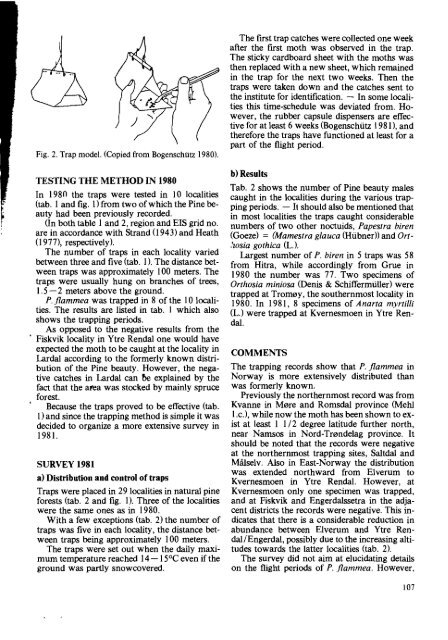o .eg an Jo of En1tomol0lD' - Norsk entomologisk forening
o .eg an Jo of En1tomol0lD' - Norsk entomologisk forening
o .eg an Jo of En1tomol0lD' - Norsk entomologisk forening
- No tags were found...
You also want an ePaper? Increase the reach of your titles
YUMPU automatically turns print PDFs into web optimized ePapers that Google loves.
Fig. 2. Trap model. (Copied from Bogenschiitz 1980).<br />
TESTING THE METHOD IN 1980<br />
In 1980 the traps were tested in 10 localities<br />
(tab. I <strong>an</strong>d fig. 1) from two <strong>of</strong>which the Pine beauty<br />
had been previously recorded.<br />
(In both table 1 <strong>an</strong>d 2, r<strong>eg</strong>ion <strong>an</strong>d EIS grid no.<br />
are in accord<strong>an</strong>ce with Str<strong>an</strong>d (I 943) <strong>an</strong>d Heath<br />
(I 977), respectively).<br />
The number <strong>of</strong> traps in each locality varied<br />
between three <strong>an</strong>d five (tab. 1). The dist<strong>an</strong>ce between<br />
traps was approximately 100 meters. The<br />
traps were usually hung on br<strong>an</strong>ches <strong>of</strong> trees,<br />
I.5- 2 meters above the ground.<br />
P. jlammea was trapped in 8 <strong>of</strong> the 10 localities.<br />
The results are listed in tab. 1 which also<br />
shows the trapping periods.<br />
As opposed to the n<strong>eg</strong>ative results from the<br />
• Fiskvik locality in Ytre Rendal one would have<br />
expected the moth to be caught at the locality in<br />
Lardal according to the formerly known distribution<br />
<strong>of</strong> the Pine beauty. However, the n<strong>eg</strong>ative<br />
catches in Lardal c<strong>an</strong> fle explained by the<br />
fact that the atea was stocked by mainly spruce<br />
forest.<br />
Because the traps proved to be effective (tab.<br />
I) <strong>an</strong>d since the trapping method is simple it was<br />
decided to org<strong>an</strong>ize a more extensive survey in<br />
1981.<br />
SURVEY 1981<br />
a) Distribution <strong>an</strong>d control <strong>of</strong> traps<br />
Traps were placed in 29 localities in natural pine<br />
forests (tab. 2 <strong>an</strong>d fig. 1). Three <strong>of</strong> the localities<br />
were the same ones as in 1980.<br />
With a few exceptions (tab. 2) the number <strong>of</strong><br />
traps was five in each locality, the dist<strong>an</strong>ce between<br />
traps being approximately 100 meters.<br />
The traps were set out when the daily maximum<br />
temperature reached 14 - 15°C even if the<br />
ground was partly snowcovered.<br />
The first trap catches were collected one week<br />
after the first moth was observed in the trap.<br />
The sticky cardboard sheet with the moths was<br />
then replaced with a new sheet, which remained<br />
in the trap for the next two weeks. Then the<br />
traps were taken down <strong>an</strong>d the catches sent to<br />
the institute for identification. - In some localities<br />
this time-schedule was deviated from. However,<br />
the rubber capsule dispensers are effective<br />
for at least 6 weeks (Bogenschutz 1981), <strong>an</strong>d<br />
therefore the traps have functioned at least for a<br />
part <strong>of</strong> the flight period.<br />
b) Results<br />
Tab. 2 shows the number <strong>of</strong> Pine beauty males<br />
caught in the localities during the various trapping<br />
periods. - It should also be mentioned that<br />
in most localities the traps caught considerable<br />
numbers <strong>of</strong> two other noctuids, Papestra biren<br />
(Goeze) = (Mamestra glauca (Hubner» <strong>an</strong>d Ort<br />
.'lOsia gothica (LJ<br />
Largest number <strong>of</strong> P. biren in 5 traps was 58<br />
from Hitra, while accordingly from Grue in<br />
1980 the number was 77. Two specimens <strong>of</strong><br />
Orthosia miniosa (Denis & Schiffermuller) were<br />
trapped at Trom0Y, the southernmost locality in<br />
1980. In 1981, 8 specimens <strong>of</strong> Anarta myrtilli<br />
(L.) were trapped at Kvernesmoen in Ytre Rendal.<br />
COMMENTS<br />
The trapping records show that P. jlammea in<br />
Norway is more extensively distributed th<strong>an</strong><br />
was formerly known.<br />
Previously the northernmost record was from<br />
Kv<strong>an</strong>ne in M0re <strong>an</strong>d Romsdal province (Mehl<br />
I.e.), while now the moth has been shown to exist<br />
at least 1 1/ 2 d<strong>eg</strong>ree latitude further north,<br />
near Namsos in Nord-Tf0ndelag province. It<br />
should be noted that the records were n<strong>eg</strong>ative<br />
at the northernmost trapping sites, Saltdal <strong>an</strong>d<br />
MaIselv. Also in East-Norway the distribution<br />
was extended northward from Elverum to<br />
Kvernesmoen in Ytre Rendal. However, at<br />
Kvernesmoen only one specimen was trapped,<br />
<strong>an</strong>d at Fiskvik <strong>an</strong>d Engerdalssetra in the adjacent<br />
districts the records were n<strong>eg</strong>ative. This indicates<br />
that there is a considerable reduction in<br />
abund<strong>an</strong>ce between Elverum <strong>an</strong>d Ytre Rendal/Engerdal,<br />
possibly due to the increasing altitudes<br />
towards the latter localities (tab. 2).<br />
The survey did not aim at elucidating details<br />
on the flight periods <strong>of</strong> P. jlammea. However,<br />
107

















